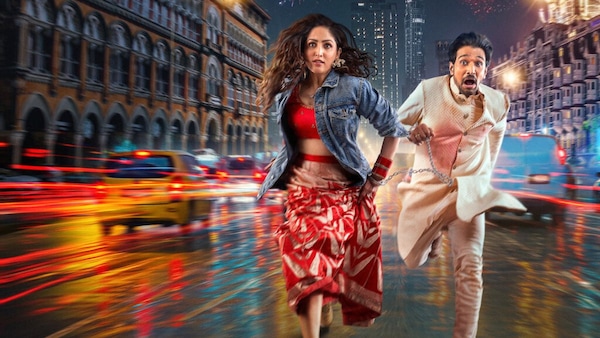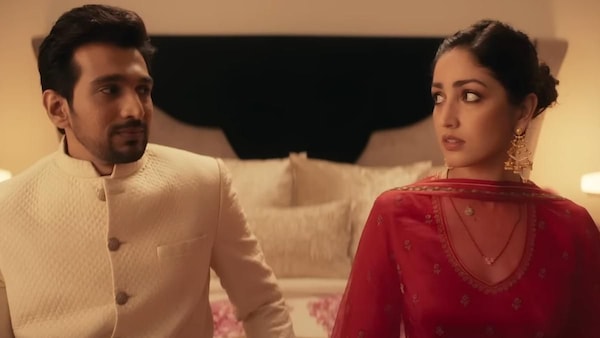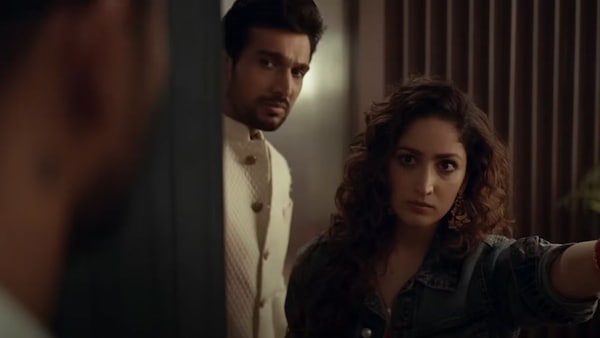Dhoom Dhaam: Yami Gautam Dhar & Pratik Gandhi Are Wasted In This Trip To Nowhere
Dhoom Dhaam proves through its existence that the OTT platforms have become more of a dumping ground for middling films that have nowhere else to go or, in the spirit of the film, run.

Promo poster for Dhoom Dhaam | NetflixNetflix
Last Updated: 02.13 PM, Feb 14, 2025
RISHAB SETH's Dhoom Dhaam, a silly film that unfolds across one night, is made on vibes. There is no other way to explain it. Here is what might have happened. The filmmaker envisioned certain scenes and scored them to a catchy tune in his head. And then he got so immersed in the execution that he forgot to make any effort to connect them, causing the outing to resemble a disjointed deadbeat of an endeavour that lights up, ever so lightly, with hilarity. But the feeling is so transient that you forget about it till it comes back again. Not ironic that for a film about a couple on the run, Dhoom Dhaam makes you play catch up with your own emotions.
None of this was necessary. The premise is inventive, almost a clutter-breaker amidst the slews of remakes and adaptations that we are finding ourselves in. It starts with a hastily arranged marriage of a shy Gujarati man Veer Poddar (Pratik Gandhi) and a conventional girl from Mumbai Koyal Chadda (Yami Gautam Dhar). They are nervous during the first night. They have reasons to be. Overbearing relatives made it impossible for them to even talk and the courtship period was as good as absent. But as they sit on the bed together, both coy and eager, a knock on the door upturns their lives. Two men barge in wanting what they call “Charlie” and thus begins a cat-and-mouse chase game through the night.

See? Not half as bad. But Seth, who shares writing credits with Aditya Dhar and Aarsh Vora (both of whom had collaborated in Article 370), embarks on a quizzical tour, adorned with thorny questions and questionable twists. A setting like this is bound to have confusion but the film mistakes that for being confusing— not a good look. Beyond the novelty of the first 15 minutes, Dhoom Dhaam rehashes every trope in the history of mainstream Hindi cinema, ranging from manic pixie girl and shy boy, staple red herrings, cops changing sides faster than one breathes, and ends up doing a disservice to all of them.
For instance, five minutes into the film Koyal is revealed to be unlike anything her parents had said. She drinks, she smokes, she cusses. At this point, these pointers are ancient markers of modernity but the writers, moving on a decade too late, imbue the character with just sparks. Ditto for Veer who is a diminished portrait of frail masculinity. He is scared of everything and is plagued with a hundred phobias but when it comes to Koyal, he becomes a changed man. One could sell these underbaked ideas, if the writing had enough conviction or even sweeping romanticism. But Dhoom Dhaam is too busy flashing its badge of honour than letting others discover it.

As the night advances, things fall into place for Koyal and Veer. The men running after them are looking for a pen drive (“Charlie”; don’t ask) which contains incriminating evidence against some cops who were involved in a betting scandal (Mukul Chadda wasted in one could have been a fun role). The pen drive should have been in one of the gift bags Koyal had given away to her bachelorette but she was too drunk and there were many people.
Dhoom Dhaam takes as many rounds within this set-up as possible but flatly refuses to accrue any urgency. We hear their families are held hostage but Koyal and Veer take more breaks than many IT professionals take smoke breaks. She gets drunk, he dances for a female crowd, she sermonises on the lack of freedom women are afforded and he listens. She again sermonises and he listens again.
This goes on for so long that one forgets that – they were running; their parents are held at gunpoint; what on earth is Charlie; and seemingly half of Mumbai police are after them. This flab draws attention to other, what I would have considered, insignificant things. Like the length of Koyal’s lehenga getting conveniently altered with each scene, the many cheat shots the filmmaker takes (the characters jump from railway station to road whenever it serves the plot), and that the police officers somehow always know where they are. One could have put it down to their slow speed but the film hints that they are being tracked till it sidesteps any such possibilities.

The little joy that comes from watching Dhoom Dhaam is seeing Gandhi, however, it soon becomes evident that Bollywood is doing to him what it does to everything new and good: the industry is standardising him to the point where most of his characters look and feel alike. He brings the physical comedy of Madgaon Express and the reticence of Do Aur Do Pyaar but Seth’s film gives him barely anything else to expand upon. Dhar’s turn is more of a reiteration and unfurls like she has watched Jab We Met one too many times.
At this point a Hindi film streaming directly on Netflix is more of a cautionary tale than a distinction. Dhoom Dhaam pushes the reputation only further, proving through its existence that the digital sites have become more of a dumping ground for middling films that have nowhere else to go or, in the spirit of the film, run.
Dhoom Dhaam is currently streaming on Netflix.

 Premium
Premium